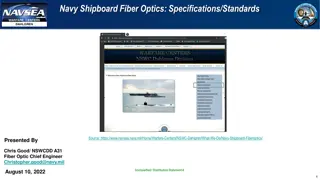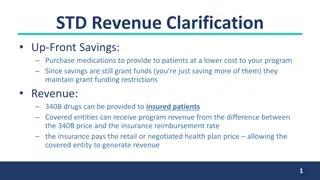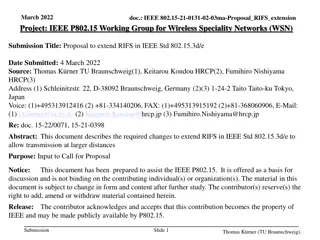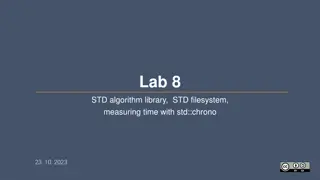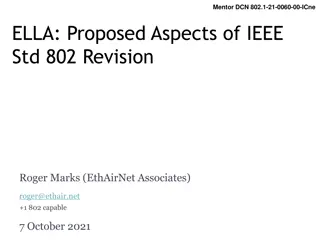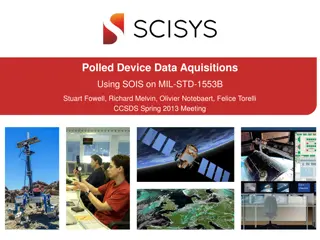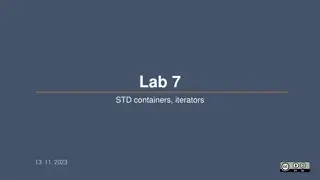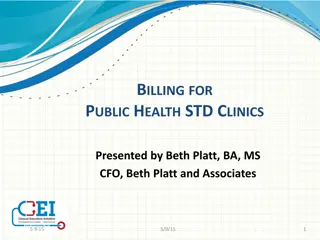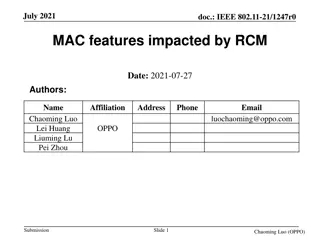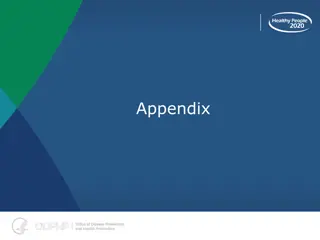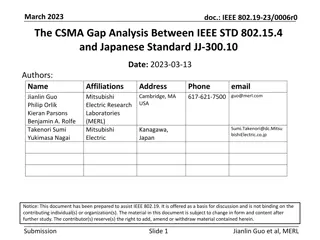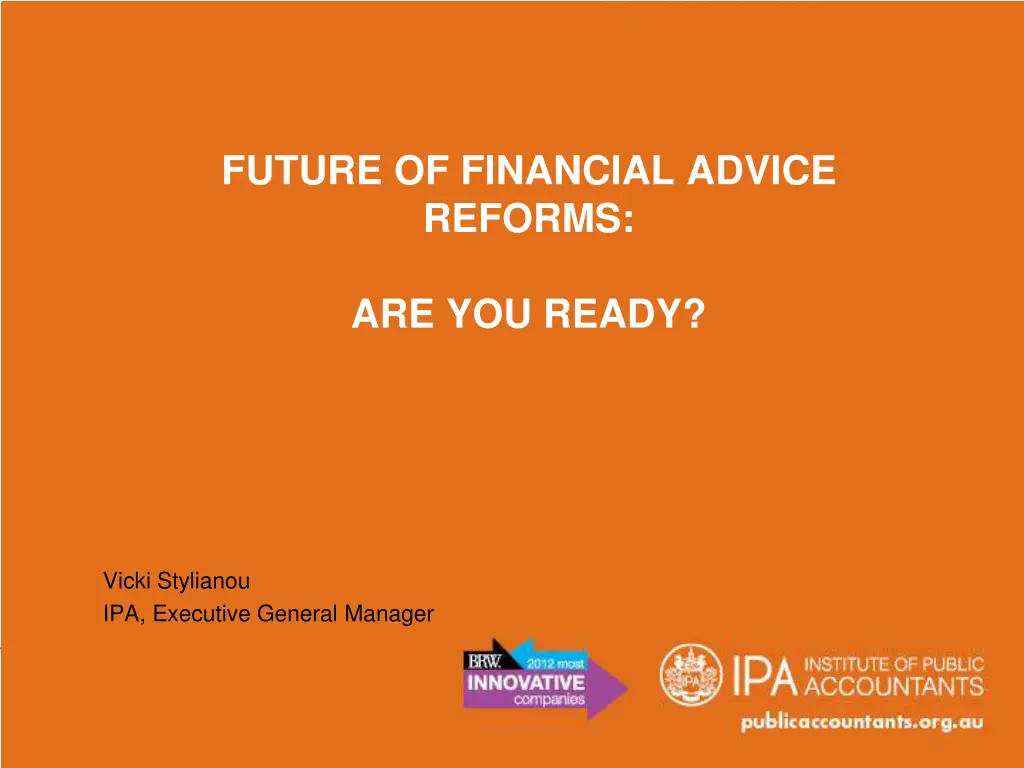
Financial Advice Reform Insights: Challenges and Opportunities
Explore the future of financial advice reforms through research, trends, and challenges faced by small to medium-sized practices. Discover key drivers of profitability, sources of new revenue, and challenges for SME clients and SMPs. Stay informed on the latest developments in the financial services industry.
Download Presentation

Please find below an Image/Link to download the presentation.
The content on the website is provided AS IS for your information and personal use only. It may not be sold, licensed, or shared on other websites without obtaining consent from the author. If you encounter any issues during the download, it is possible that the publisher has removed the file from their server.
You are allowed to download the files provided on this website for personal or commercial use, subject to the condition that they are used lawfully. All files are the property of their respective owners.
The content on the website is provided AS IS for your information and personal use only. It may not be sold, licensed, or shared on other websites without obtaining consent from the author.
E N D
Presentation Transcript
FUTURE OF FINANCIAL ADVICE REFORMS: ARE YOU READY? Vicki Stylianou IPA, Executive General Manager
OVERVIEW Research Challenges Trends and opportunities Context Background Update Options FoFA Financial services Decision-making process AR or own license What is IPA doing for Members
Context: Research Challenges Trends and opportunities
RESEARCH: SIZE OF PRACTICES IFAC Global SMP survey, released March 2015, shows: 31% of accounting practices are sole practitioners 30% have 2-5 professional staff 15% have 6-10 professional staff IPA: 50% sole practitioners 36% 2-5 practitioners
DRIVERS OF PROFITABILITY IFAC Global SMP survey 2015 shows: 34% said acquisition of new clients 33% said better retention of existing clients 11% said increased productivity 9% said reduced overheads 9% said increase average fee size
SOURCES OF NEW REVENUE Fastest growing source of new revenue for SMPs: 48% said tax 50% said advisory and consulting services 27% said accounting/compilation services 10% said audit These percentages held across all SMP size segments
CHALLENGES FOR SME CLIENTS IFAC Global SMP survey 2015 shows that greatest challenges for SME clients: 66% said economic uncertainty 67% said rising costs Changes from 2014 to 2015 rising costs and economic uncertainty have seen a huge increase
CHALLENGES FOR SMPS IFAC Global SMP Survey 2015 shows: 58% said attracting and retaining new clients 51% said pressure to lower fees 57% said keeping up with new regulations and standards 50% said rising costs 50% said differentiating from the competition .
SURVEYS WHATS HAPPENING 2014 CoreData survey shows: 37% of accountants intend to get licensed closer to June 2016 24% intend to get a limited license within 18mths to 3yrs 15% already delivering full advice to clients 14% have no intention of getting licensed 10% intend to move to a full license model
IPA FOFA SURVEY IPA Member survey in 2015: 32% are already RG146 compliant 14% are not sure about becoming RG146 compliant 17% said they were going to get their own license 22% already have a referral arrangement in place 22% either don t deal with SMSFs or are going to exit the sector 41% are not sure about how they are going to become licensed 48% are not sure about when they are going to get licensed 19% said they will become licensed in the second half of 2015 15% said they will become licensed in the first half of 2016
CHALLENGES MACRO Technology commoditising compliance work common message but pace is accelerating Technology increasing efficiencies eg pre-filling, e-tax, MyTax, tax apps, cloud enabling real time access to ATO etc ATO Reinvention program posing risks through disintermediation Banks working with software providers also posing risks through disintermediation Leveraging technology to stay ahead and to enable more efficient compliance Globalisation offshoring and outsourcing putting pressure on margins and profits Govt policy and regulations increasing complexity or uncertainty; and need to keep up to date becoming relentless Succession planning who will buy or take over How much is your practice worth financial services increase the multiple Increased competition from various sectors including banks, planners, lawyers, brokers, internet, offshore, technology companies etc And so on
RESEARCH Research on SMSFs: June 2014 report from NAB shows that SMSFs have significantly outperformed their APRA-regulated rivals in six out of the past eight years surveyed, by 22.5%, after paying all costs But April 2014 Investment Trends report shows that SMSF assets grew by 13% over year to March 2014, while retail fund assets grew 18% and industry fund assets grew 16% If market going well then demand for SMSFs declines Research on SMSFs and advisers: SMSF specialisation growing within financial planning; with more revenue for specialists v generalists 15% of accountants in public practice providing advice on SMSFs are authorised to provide investment advice; and another 13% are RG146 compliant Of the 38,000 accountants in public practice, about 86% (33,000) advise SMSFs 30% annual increase in outsourcing SMSF administration to a specialist provider across accountants, financial planners and SMSF trustees Source Investment Trends and Vanguard, April 2013 and March 2014
TRENDS AND OPPORTUNITIES 45% of SMSF investors currently using an accountant solely for tax advice said they would consider using them for financial and investment advice if they offered it 286,000 SMSFs would pay $2,500 for advice 301,000 SMSFs have an advice gap Many areas of advice in demand including inheritance and estate planning, age and SMSF pension planning, asset and income protection etc Number of SMSFs open to using advisers expertise is at highest levels seen Source Investment Trends, April 2014
ACCOUNTANTS AND FINANCIAL PLANNERS Number of SMSF trustees using a financial planner as their primary source of advice is increasing, as opposed to last year where it was accountants Financial planners are now the most trusted source of advice for setting up an SMSF Financial planners are more likely than accountants to hold specialist SMSF qualifications (58.9% vs. 43.7%) 75.0% of accountants without these qualifications believe they are not necessary. Accountants tend to turn to CPD instead, undertaking slightly more SMSF-related PD hours every year compared to financial planners (25 hours vs. 22.6 hours) However, there is strong appetite among accountants for further education, with 51.7% of accountants intending to obtain SMSF specialist qualifications in the next three years (compared to 40.3% planners) Source Fourth annual Intimate with Self-Managed Superannuation report by SPAA, Russell Investments and CoreData 2014
Future of Financial Advice reforms: Background Update Options for Members
BACKGROUND Accountants exemption replaced by limited license under FoFA Transition period for accountants from 1 July 2013 to 30 June 2016 During transition period accountants prior experience will be recognised for licensing if have PPC with either IPA, CPAA or CAANZ From 1 July 2016 accountants wanting to provide advice on SMSFs will need an AFSL or be an authorised representative (AR) of an AFSL holder Much broader scope of advice than under exemption (see below) Review of knowledge 3 yrs after license granted Administered and enforced by ASIC under Corporations Act
SCOPE OF ADVICE Limited AFSL holders will be able to provide advice on: SMSFs as a product ie personal or general product advice Superannuation at the class of product level Securities at the class of product level Simple managed investment schemes as defined in the Corporations Regulations General and life insurance at the class of product level Basic deposit products
DEFINITIONS Term Product advice Meaning Influencing a decision about a particular financial product or intending to influence the decision Advice and recommendations relating to a class of product but not a specific product ie financial advice that does not make a recommendation (in form or substance) about a specific financial product That the provider of the advice has considered one or more of the person's objectives, financial situation and needs; or a reasonable person thinks one or more of those factors have been considered Not personal financial advice (see above) - A recognised accountant (member of IPA, CPAA or CAANZ) or hold ASIC approved practicing certificate - Applied for a limited license between 1July 2013 and 1 July 2016 - Does not deal with money Applying, acquiring, issuing, underwriting, varying, or disposing of a financial product on behalf of a client Class of product Personal financial advice General financial advice Limited licensee Deal in an interest
WHAT IS FINANCIAL ADVICE? A statement, report or opinion that: Is designed to influence a person or persons to make a decision on a financial product or class of financial product; or Can be reasonably regarded as being intended to have such an influence Personal Advice General Advice The provider of the advice has considered one or more of the person s objectives, situation and needs; or All other product advice that does not consider these matters; or A reasonable person would not have expected one or more of these matters to be considered A reasonable person might expect the provider to have considered one or more of these matters
DIFFERENT LEVELS AND CATEGORIES Consumers must decide if they want: factual information, general advice or personal advice Advice is based on a continuum says ASIC, not specific categories of advice Then adviser must decide whether advice is classified as: intra-fund, scaled, limited or full Each category has different levels of professional competency, compliance requirements, disclosure requirements and fees
EXAMPLES OF FOFA ADVICE Examples include advice on: Types of life insurance cover, total and permanent disability, trauma cover, income protection, whether to hold directly or through superannuation fund Which simple managed investment scheme is the most appropriate, eg cash or equity fund Which class of product is the most appropriate for the client, what is their risk profile, what are the options What type of basic deposit product, eg cheque or savings, term deposit, online savings account, various business related accounts ASIC RGs provide further guidance
EDUCATION REQUIREMENTS: RG 146 ASIC s Regulatory Guide 146 relates to knowledge and skill requirements for individuals Courses required for each type of advice eg superannuation, life insurance, securities etc Education must cover generic knowledge, specialist knowledge and relevant skills Licensees require all ARs to hold RG 146 at least Ongoing CPD requirements Many different offers in the market Currently ASIC is trying to increase the standards of education but industry is resisting Some financial service providers, including AMP, BT, NAB/MLC, have already announced increases in required qualifications
EDUCATION REQUIREMENTS: RG 105 ASIC s Regulatory Guide 105 relates to Licensing and the Organisational Competence Requires you to be competent at the organisational level Nominate a Responsible Officer(s) ASIC assesses compliance by looking at the knowledge and skills of Responsible Officer(s)
ACCOUNTANTS LICENSING REGIME SUMMARY What is it? Advice scope Licensee responsibilities SMSF Class of product advice on: Basic deposit products General & life insurance Securities Simple managed investment schemes Broad compliance obligations Internal system obligations People obligations - Compliance with laws - Adequately trained - Maintain competency to provide advice Resourcing obligations - People requirements - Technical resources - Financial resources License issued by ASIC New AFSL available for all participants in financial services Accountants with Public Practicing Certificate can gain access to transition provisions Corporations Act applies The licence will allow: - SMSF recommendations - Class of product advice
GOVT POSITION Policy is based on consumer protection Scaled advice expected to make advice more accessible and affordable Initial estimate was that 10,000 accountants will apply for a limited AFSL Treasury states the reforms will expand new markets for accountants Increased monitoring from ASIC expected ASIC to conduct review at end of transition period Coalition Govt supports the main principles of FoFA which were introduced by previous Govt However, Coalition Govt s proposed amendments defeated in the Senate
UPDATE: LEGISLATION Govt made election promise to amend FoFA but defeated in attempts There are NO changes to the accountants exemption accountants will still have to be licensed to provide advice about SMSFs and other financial advice What were the main changes which had been proposed: o removal of opt-in o annual fee disclosure statement for post-1 July 2013 clients only oamend best interests duty to remove catch all from scaled advice o scope of scaled advice can be explicitly agreed with client o general advice exempted from conflicted remuneration (but not personal advice) o amend grandfathering to allow for adviser movements (allowed) o new public register of advisers for consumers to use to start in March 2015
UPDATE CONT Govt estimates that changes will save industry $190 million pa in ongoing compliance costs and $88 million in once-off implementation costs Reaction was mixed financial services industry has welcomed some changes; with industry super and some consumer groups not as welcoming; banks would have been major winners from general advice exemption but have backed down; financial planning sector disagrees with general advice exemption IPA supported removal of catch all to best interests duty, which would have aided scaled advice Catch all may lead to uncertainty and going through much longer process than may actually be needed or requested will clients pay for this? Slashes to ASIC funding in 2014 Budget might impact FoFA implementation/ enforcement wait and see 2015 Budget more cuts expected
UPDATE: ASIC AND LICENSING ASIC has license application 3 part kit and 65 page form (not all applicable) refer to: http://www.asic.gov.au/asic/asic.nsf/byheadline/13- 140MR+ASIC+releases+information+sheet+about+applying+for+a+limited+AFS+lic ence?openDocument Initial form has been streamlined by ASIC with removal of some questions ASIC has reinstated training register of RG 146 providers Still need to meet financial and compliance requirements including: have a system to manage risk; membership of an external dispute resolution scheme like FOS; must have internal dispute resolution scheme; adequate training of certain employees; ongoing relevant CPE; appropriate business processes in place; adequate PI insurance to cover areas of authorisations Other FoFA reforms contained in Corporations Act all apply Annual compliance certificate rather than full AFSL audit Knowledge review after three years of obtaining license
Financial services: Decision-making process Authorised representative or own license What is IPA doing for Members
FIVE MAIN OPTIONS UNDER FOFA Option 1: Get out of the sector altogether Option 2: Stay in the sector but refer clients Option 3: Become an AR of a licensee Option 4: Apply to ASIC for a limited/full license Option 5: Obtain a limited license and have a referral network
DECISION-MAKING PROCESS Professional referral relationship 3 No 2 Revenue sharing Provide in-house? 1 Yes Own AFSL Yes Provide SMSF advice to clients Authorised Representative No No action required
WHAT TO CONSIDER Essentially a business decision what is your business model Consider opportunities and challenges Determine if you are impacted Assess services you currently provide Assess services your clients want from you What are other, similar practices doing Consider the options Meet education requirements (RG146) Meet other requirements (fit & proper person, PI insurance, responsible manager etc)
COST OF LICENSE Application fee to ASIC for individual: $825 Application fee to ASIC for company: $1,485 Increased PI insurance (min $2m): could be significant Membership of external dispute resolution scheme: $500 - $1,000 Ongoing training and education of relevant staff: depends Adequate practice management processes: may be minimal if already in place Annual compliance certificate instead of full audit (latter can be $2,000 to $10,000) Cost of preparing full AFSL application: $10,000 to $20,000 or more
WHY CONSIDER FINANCIAL SERVICES Client demand for holistic advice and additional services Revenue and profit growth (client base penetration from 10% - 90%) Ring-fence your clients revenue and profit protection being the only or main trusted adviser in the financial or business life of your clients Diversify, grow and sustain client base and revenue sources Consider challenges to traditional accounting work refer above to macro challenges
PREPARATION IS THE KEY Yourself Your business Your clients Consider additional resources required In-house or outsourcing? New entity / trading name Referral relationships Competitive advantage Education Training Authorisation/license level required AR or AFSL? Delivery of advice to clients requires templates and processes such as: Statement of Advice Fact Find Financial Services & Credit Guide Record of Advice Statement of Further Advice File Notes Advice Processes Registers
INCORPORATING FINANCIAL SERVICES According to various commentators the keys to success in financial services are: Integrated business model Client-centric attitude and approach Client engagement model Cohesive, quality delivery of advice Consistent remuneration and fee approach Recognition of separate and distinct skill sets
COST V. OPPORTUNITY Revenue source Explanation Estimated amount Advice fee (advice business) For the preparation of Statement of Advice, including a consideration of whether SMSF is appropriate for client $1,000 - $2,000 Implementation fee (accounting business) Establish the structure and arrange documentation $1,500 - $2,500 Ongoing tax work (accounting business) Annual tax return, BAS, actuarial certificates (if applicable) $2,000 - $3,000
AUTHORISATION or OWN LICENSE? Cost Risk Working capital Initial and ongoing costs Professional Indemnity insurance Profitability Productivity Efficiency Diversity of income sources Reputational risk Monitoring from ASIC or licensee Responsible Manager Overall compliance Referral effect on clients Client base protection Capacity to seize growth opportunities, especially SMSFs Independence Client ownership Ability to use own brand Ability to recommend a wide range of products (if applicable) Creation of an asset Autonomy Structure JV with equity, merger etc Resources Advice document templates etc Ongoing CPD Technical support Monitoring and supervision Business resourcing and preparation Ease of implementation Marketing and differentiation Additional skill sets needed
AUTHORISED REPRESENTATIVE What is it? Advice scope AR responsibilities Three options: 1. SMSF advice 2. SMSF advice, strategic advice and class of product advice 3. Strategic and product advice Letter of Authority to provide advice is issued by a licensee Access to licensee resources Access to practice management support Benefit of scale of economies Transfers risk and responsibility to licensee However, resources, cost structure etc vary greatly by licensee Comply with standards set by the licensee Comply with obligations associated with providing financial advice No financial obligations Licensee is held ultimately responsible for the advice provided Options vary by licensee make sure you compare the detail, not just the upfront price
LIMITED LICENSE Apply for a license directly with ASIC (limited or full) Must have education requirements and experience deemed until 2016 During transition period PPC holders of three accounting bodies do not have to prove relevant experience Comply with all FoFA measures including disclosure obligations, documentation, processes etc Refer to ASIC website, www.asic.gov.au for details of all applicable Regulatory Guides Three part application kit with 65 pages (not all applicable) and need to compile docs around four core areas ASIC and IPA can assist with applications Many applications have been rejected as incomplete if applying make sure you have accurately completed all requirements and provide ALL documents before pressing submit
WHAT IS IPA DOING FOR MEMBERS Updating information Ongoing consultation with ASIC re implementation Education offering for RG 146, DFP and ADFP Partnerships with AFSL holders to provide AR licensing and referral services Partnership extended to assist limited license holders Partnership with Shadforths to provide a formal network arrangement for Members which also provides a revenue stream for Members Insurance solution: in-house broker to negotiate better deals Tell us what else you need or want from IPA
IPA SOLUTION FOR AR IPA has gone to tender and selected AFSL holders on behalf of Members IPA has partnered with five licensees to assist Members who wish to introduce financial services into their practices and to offer choice Partners are: o SMSF Advice owned by AMP, offers three levels of licensing at flat fee and many resources offered under AMP umbrella o BT/Securitor owned by Westpac and offers various levels of licensing and fees/revenue split o Shadforths owned by IOOF, mid-tier and offers referrals and B2B solutions o Capstone non-aligned mid-tier group with various levels of licensing o Accountable non-aligned boutique group offering licensing and solutions for accountants with limited license For more information on the IPA partners contact: Vicki Stylianou Vicki.stylianou@publicaccountants.org.au or Mob. 0419 942 733
IPA SOLUTION FOR LIMITED LICENSE IPA will assist with application to ASIC Once licensed, our partners offer packages to assist with documentation, templates, checklists, how-to guides (especially disclosure obligations), samples (fact finds, FSGs, SOAs, engagement letters, invoicing for scaled advice etc), technical assistance oIPA s PPQA Online (quality assurance program) has added SMSF and financial advice modules; and can be used as both a business diagnostic tool and for compliance reporting to ASIC o IPA can assist Members with ongoing liaison with ASIC to avoid non- compliance (ASIC has warned against FoFA window dressing )
IPA REFERRAL SERVICE IPA is developing a more hands-on referral solution which actively matches accountants and planners through one of our partners (which has salaried planners) Shadforths The service is for Members who don t wish to become licensed but still wish to offer financial services to their clients Members can make additional revenue from referrals contractual arrangement Members can be referred in the meantime by contacting IPA and being put in direct contact with Shadforths
CONTACT US If you have any questions or would like further information or wish to discuss your particular situation then please call either: Vicki Stylianou: vicki.stylianou@publicaccountants.org.au or mob. 0419 942 733 Tony Greco: tony.greco@publicaccountants.org.au or 03 8665 3134 For education or training queries please refer to: Jenny Toh: jenny.toh@publicaccountants.org.au For insurance queries please refer to: David Martin: david.martin@publicaccountants.org.au or 03 8665 3139





